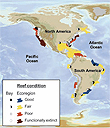Roughly 85 percent of the world’s oyster beds have disappeared and in many locations oysters are functionally extinct due to overharvesting and disease, according to a new study. In a wide-ranging survey of
144 bays and 44 ecoregions globally, an international research team found that in many regions, such as the Wadden Sea in Europe and Narragansett Bay in the northeastern U.S., only 1 percent of once-abundant oyster beds remain. Even the ecoregions in North America — where most of the world’s native oysters are harvested — are in “poor” condition, according to the study published in the journal BioScience. The exception is the Gulf of Mexico, which Michael Beck, a scientist with The Nature Conservancy and the University of California, Santa Cruz, says represents “probably the last opportunity to achieve large-scale oyster reef conservation and sustainable fisheries.” The researchers urged better mapping of oyster resources and the removal of incentives to overexploit wild oyster populations.
World’s Oyster Populations Have Declined Precipitously, Study says
More From E360
-
Solutions
In Seawater, Researchers See an Untapped Bounty of Critical Metals
-
INTERVIEW
Tracking Illicit Brazilian Beef from the Amazon to Your Burger
-
Solutions
In a Dammed and Diked Mekong, a Push to Restore the Flow
-
INTERVIEW
How One South African Community Stopped Shell Oil in Its Tracks
-
ANALYSIS
Will New Leader End Progress in Saving Indonesia’s Forests?
-
Oceans
Dire Straits: Can a Fishing Ban Save the Elusive European Eel?
-
Climate
Scientists Are Trying to Coax the Ocean to Absorb More CO2
-
INTERVIEW
Marina Silva on Brazil’s Fight to Turn the Tide on Deforestation
-
Solutions
Solomon Islands Tribes Sell Carbon Credits, Not Their Trees
-
INTERVIEW
With Sea Turtles in Peril, a Call for New Strategies to Save Them
-
RIVERS
Jared Kushner Has Big Plans for Delta of Europe’s Last Wild River
-
Energy
A Nuclear Power Revival Is Sparking a Surge in Uranium Mining
